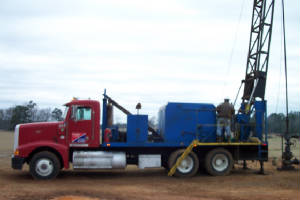 Swabbing is the act of pulling fluid from the well bore through the use of wire rope and cup assembly. Swabbing equipment includes a swabbing assembly, lubricator with an oil saver, and shut-off valve on the well, also called a swabbing valve.
Swabbing is the act of pulling fluid from the well bore through the use of wire rope and cup assembly. Swabbing equipment includes a swabbing assembly, lubricator with an oil saver, and shut-off valve on the well, also called a swabbing valve.
General precautions during all swabbing operations:
- Conduct swabbing operations during daylight hours.
- Keep all personnel clear of the derrick or within six feet (two meters) of the wellhead during swabbing operations.
- Locate swab tanks at least 100 feet (30 meters) from the well, where location allows.
Potential Hazard:
- Loss of well control.
Possible Solutions:
- Use appropriate equipment, rated for the expected pressures, to shut in the well.
- Inspect lubricators, swages, and unions for defects such as cuts, corrosion, and thread damage before use.
- Adjust oil savers by remote control with a hydraulic pump placed safely away from the wellhead.
- Train all personnel in emergency evacuation procedures.
Potential Hazard:
- Fire, explosive, or respiratory hazard from leakage or venting of oil or gas from tanks, lines or lubricator.
Possible Solutions:
- Place fire extinguishers in accessible positions.
- Move sources of potential ignition (such as, open fires for melting of babbitt) to designated areas at a safe distance from the wellhead or flammable liquid storage areas such as the swab tank before swabbing.
- Make provisions to contain spilled flammable liquids.
- Monitor the oil saver for wear and potential leakage.
- Remove all spillage of flammable liquids from equipment, cellars, rig floor, and ground area adjacent to the wellhead.
- Wear proper PPE, including respiratory protection, as required.
Potential Hazard:
- Being struck by a pressurized line.
- Being exposed to a high-pressure connection failure caused by mismatched or excessively worn hammer unions.
Possible Solutions:
- Avoid approaching, walking over or standing near pressurized lines.
- Securely anchor pressurized lines to prevent whipping or bouncing caused by pressure surges.
- Use proper equipment inspection techniques to include hammer unions (Note: This is a particular problem with 602 and 1502 and others, as they will couple but will not hold beyond the lower pressure rating number).
- High Pressure Lines and Hammer Unions. International Association of Drilling Contractors (IADC) Alert 98-01, (1998).
- More On Mismatched Hammer Unions. International Association of Drilling Contractors (IADC) Alert 99-33, (1999).
- Additional Serious Incidents With Mismatched Hammer Unions. International Association of Drilling Contractors (IADC) Alert 00-15, (2000).
Potential Hazard:
- Being struck by pressurized fluids or the lubricator when removing the lubricator from the well.
- Getting strains and sprains from handling the lubricator.
Possible Solutions:
- Close the shut-off valve and bleed the pressure from the lubricator before removing it.
- Use a lubricator that will allow removal of the swab or other tools with the well shut in (valve closed).
- Use a dolly or other method to minimize manual handling of the equipment.
Potential Hazard:
- Pinching fingers between swab assembly and lubricator when changing swab cups or mandrels.
Possible Solutions:
- Use a winch line, where available, not the swab line, to handle the lubricator.
- Use a lubricator that will allow removal of the swab or other tools with the well shut in (valve closed).
Additional Information:
- Standards. American Petroleum Institute (API).
- RP 54, Occupational Safety for Oil and Gas Well Drilling and Servicing Operations. (2007, March).
Reference: osha.gov

